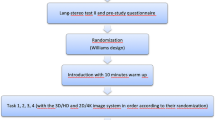Abstract
Background
Laparoscopic surgeons require extended experience of cases to overcome the lack of depth perception on a two-dimensional (2D) display. Although a three-dimensional (3D) display was reported to be useful over two decades ago, 3D systems have not been widely used. Recently, we developed a novel 3D dome-shaped display (3DD) system, CyberDome.
Study design
In the present study, a total of 23 students volunteered. We evaluated the effects of the 3DD system on depth perception and laparoscopic procedures in comparison with the 2D, a conventional 3D (3DP) or the 2D high definition (HD) systems using seven tasks.
Results
The 3DD system significantly improved depth perception and laparoscopic performance compared with the 2D system in six new tasks. We further found that the 3DD system shortened the execution time and reduced the number of errors during suturing and knot tying. The 3DD system also provided more depth perception than the 3DP and 2D HD systems.
Conclusions
The novel 3DD system is a promising tool for providing depth perception with high resolution to laparoscopic surgeons.
Similar content being viewed by others
Abbreviations
- 3DP:
-
Three-dimensional plain display
- 2D:
-
Two-dimensional display
- 3DD:
-
Three-dimensional dome-shaped display
- HD:
-
High definition
References
Becker H, Melzer A, Schurr MO, Buess G (1993) 3-D video techniques in endoscopic surgery. Endosc Surg Allied Technol 1: 40–46
Chan AC, Chung SC, Yim AP, Lau JY, Ng EK, Li AK (1997) Comparison of two-dimensional vs three-dimensional camera systems in laparoscopic surgery. Surg Endosc 11: 438–440. doi:10.1007/s004649900385
Dion YM, Gaillard F (1997) Visual integration of data and basic motor skills under laparoscopy. Influence of 2(D and 3-D video-camera systems. Surg Endosc 11): 995–1000. doi:10.1007/s004649900510
van Bergen P, Kunert W, Bessell J, Buess GF (1998) Comparative study of two-dimensional and three-dimensional vision systems for minimally invasive surgery. Surg Endosc 12: 948–954. doi:10.1007/s004649900754
Hanna GB, Shimi SM, Cuschieri A (1998) Randomised study of influence of two-dimensional versus three-dimensional imaging on performance of laparoscopic cholecystectomy. Lancet 351: 248–251. doi:10.1016/S0140-6736(97)08005-7
Wenzl R, Lehner R, Vry U, Pateisky N, Sevelda P, Husslein P (1994) Three-dimensional video-endoscopy: clinical use in gynaecological laparoscopy. Lancet 344: 1621–1622. doi:10.1016/S0140-6736(94)90412-X
Taffinder N, Smith SG, Huber J, Russell RC, Darzi A (1999) The effect of a second-generation 3D endoscope on the laparoscopic precision of novices and experienced surgeons. Surg Endosc 13: 1087–1092. doi:10.1007/s004649901179
Yamauchi Y, Shinohara K (2005) Effect of binocular stereopsis on surgical manipulation performance and fatigue when using a stereoscopic endoscope. Stud Health Technol Inform 111: 611–614
Birkett DH (1994) Three-dimensional laparoscopy in gastrointestinal surgery. Int Surg 79: 357–360
Tanoue K, Ieiri S, Konishi K et al (2008) Effectiveness of endoscopic surgery training for medical students using a virtual reality simulator versus a box trainer: a randomized controlled trial. Surg Endosc 22(4): 985–990
Cuschieri A, Szabo Z (1995) Chapter 4; Intracorporeal knots in endoscopic surgery. In: Cuschieri A, Szabo Z (eds) Tissue approximation in endoscopic surgery. ISIS Medical Media, Oxford, pp 42–67
Falk V, Mintz D, Grunenfelder J, Fann JI, Burdon TA (2001) Influence of three-dimensional vision on surgical telemanipulator performance. Surg Endosc 15: 1282–1288. doi:10.1007/s004640080053
Badani KK, Bhandari A, Tewari A, Menon M (2005) Comparison of two-dimensional and three-dimensional suturing: is there a difference in a robotic surgery setting. J Endourol 19: 1212–1215. doi:10.1089/end.2005.19.1212
Blavier A, Gaudissart Q, Cadiere GB, Nyssen AS (2007) Comparison of learning curves and skill transfer between classical and robotic laparoscopy according to the viewing conditions: implications for training. Am J Surg 194: 115–121. doi:10.1016/j.amjsurg.2006.10.014
Byrn JC, Schluender S, Divino CM et al (2007) Three-dimensional imaging improves surgical performance for both novice and experienced operators using the da Vinci Robot System. Am J Surg 193: 519–522. doi:10.1016/j.amjsurg.2006.06.042
Thomsen MN, Lang RD (2004) An experimental comparison of 3-dimensional and 2-dimensional endoscopic systems in a model. Arthroscopy 20: 419–423. doi:10.1016/j.arthro.2004.01.003
van Bergen P, Kunert W, Buess GF (2000) The effect of high- definition imaging on surgical task efficiency in minimally invasive surgery: an experimental comparison between three-dimensional imaging and direct vision through a stereoscopic TEM rectoscope. Surg Endosc 14: 71–74. doi:10.1007/s004649900015
Crosthwaite G, Chung T, Dunkley P, Shimi S, Cuschieri A (1995) Comparison of direct vision and electronic two- and three- dimensional display systems on surgical task efficiency in endoscopic surgery. Br J Surg 82: 849–851. doi:10.1002/bjs.1800820640
Pietrzak P, Arya M, Joseph JV, Patel HR (2006) Three-dimensional visualization in laparoscopic surgery. BJU Int 98: 253–256. doi:10.1111/j.1464-410X.2006.06287.x
Sun CC, Chiu AW, Chen KK, Chang LS (2000) Assessment of a three-dimensional operating system with skill tests in a pelvic trainer. Urol Int 64: 154–158. doi:10.1159/000030517
Way LW, Stewart L, Gantert W et al (2003) Causes and prevention of laparoscopic bile duct injuries: analysis of 252 cases from a human factors and cognitive psychology perspective. Ann Surg 237: 460–469. doi:10.1097/00000658-200304000-00004
Hofmeister J, Frank TG, Cuschieri A, Wade NJ (2001) Perceptual aspects of two-dimensional and stereoscopic display techniques in endoscopic surgery: review and current problems. Semin Laparosc Surg 8: 12–24. doi:10.1053/slas.2001.20835
Author information
Authors and Affiliations
Corresponding author
Additional information
This research was supported in part by a grant from the New Energy and Industrial Technology Development Organization.
Rights and permissions
About this article
Cite this article
Ohuchida, K., Kenmotsu, H., Yamamoto, A. et al. The effect of CyberDome, a novel 3-dimensional dome-shaped display system, on laparoscopic procedures. Int J CARS 4, 125–132 (2009). https://doi.org/10.1007/s11548-009-0282-5
Received:
Accepted:
Published:
Issue Date:
DOI: https://doi.org/10.1007/s11548-009-0282-5




